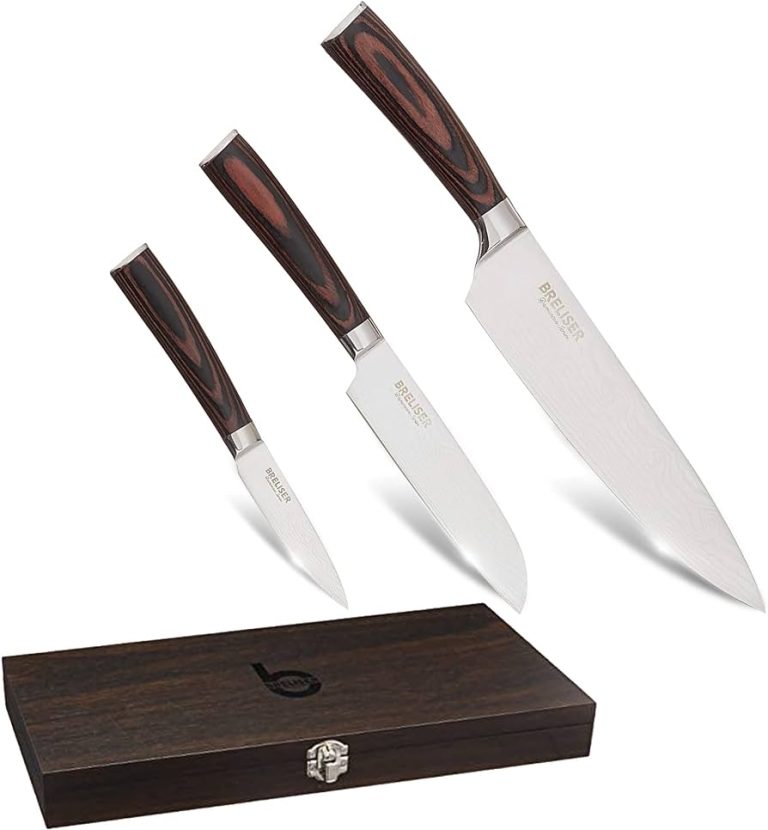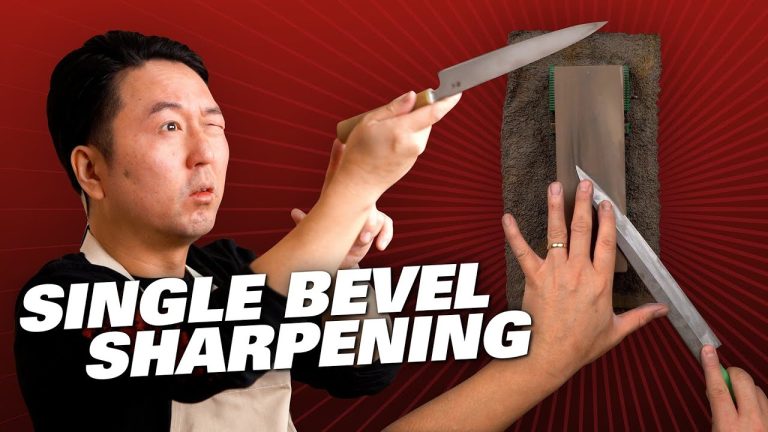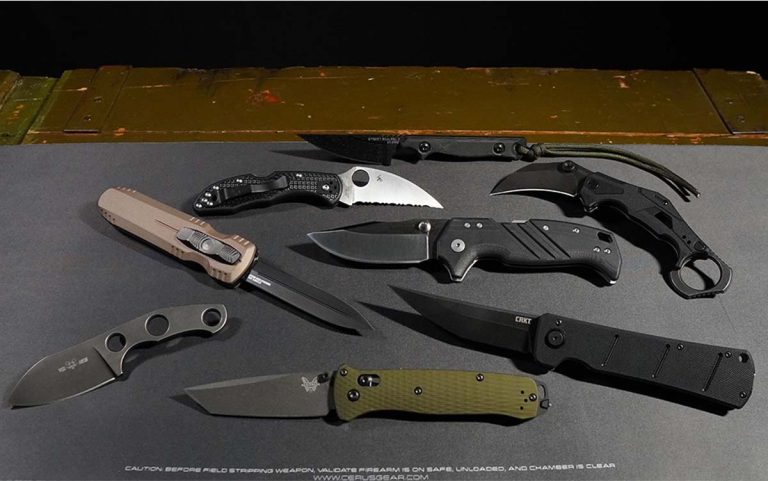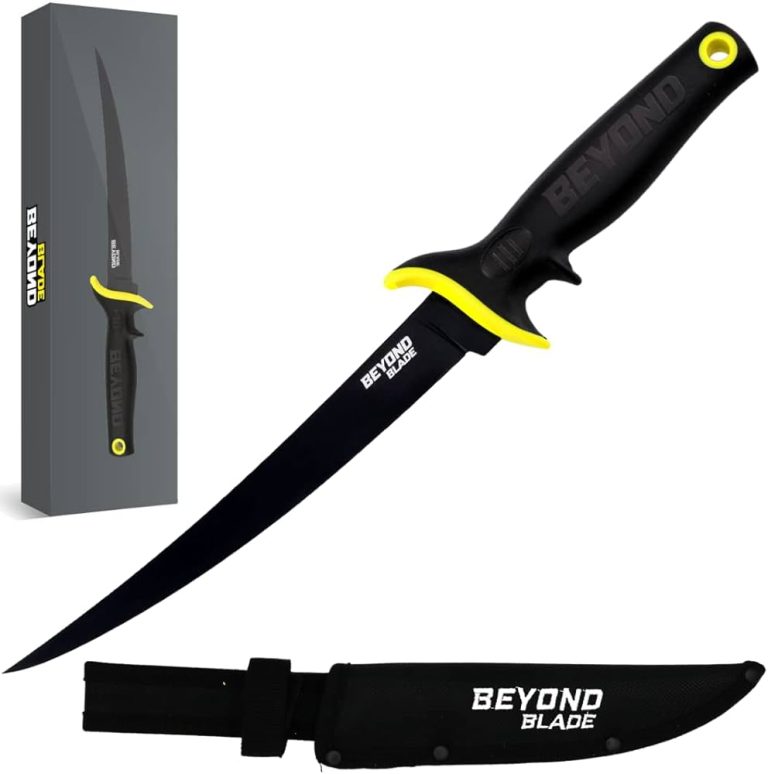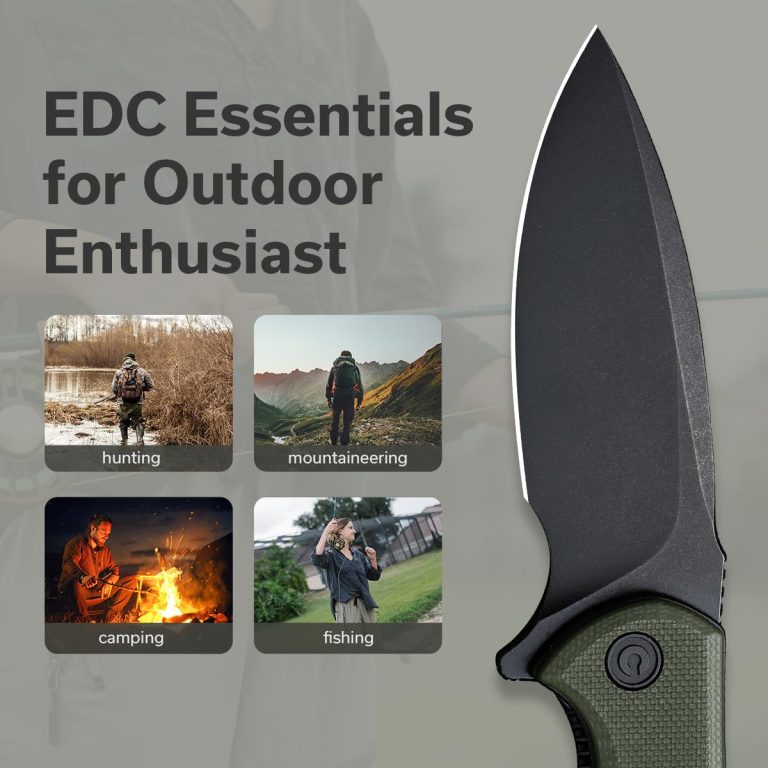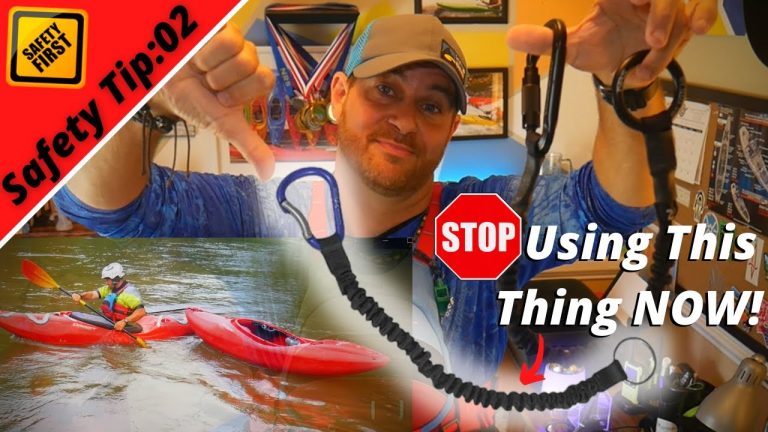Choosing the Right Camping Knife for Your Adventures
Choosing the right camping knife for your adventures is crucial for your safety and convenience. We will discuss the key factors to consider when selecting a camping knife that is reliable, durable, and suitable for your specific needs.
Whether you’re a seasoned camper or new to outdoor exploration, having a high-quality knife can make all the difference in preparing food, building shelter, or handling emergencies. From blade material and design to handle grip and safety features, we will provide valuable insights to help you make an informed decision and find the perfect camping knife for your upcoming adventures.
So, let’s dive in and explore the world of camping knives together.
Factors To Consider When Choosing A Camping Knife
Choosing the right camping knife depends on factors such as blade material, size, and handle grip. Consider your specific needs and preferences to ensure you find the perfect tool for your outdoor adventures.
Blade Length And Style
When choosing a camping knife, one of the first factors to consider is the blade length and style. The right blade length and style can greatly affect your experience and efficiency during adventures. Here are some points to keep in mind:
- Blade Length:
- A longer blade (typically around 4-6 inches) provides more versatility for various tasks like cutting through larger branches or preparing food.
- A shorter blade (around 2-3 inches) offers better control and precision when performing detailed tasks like carving or whittling.
- Blade Style:
- Drop Point: Ideal for general-purpose use, as it has a strong and versatile blade shape with a slightly curved edge and a sharp tip.
- Tanto: Known for its strength and ability to pierce, it has a straight edge and a reinforced point, making it suitable for tougher tasks.
- Clip Point: Features a concave curve on the spine and a narrow, sharp tip, making it excellent for delicate tasks and precision work.
- Spear Point: With a symmetrical design and a sharp, strong point, it offers excellent control and is suitable for a wide range of tasks.
Handle Material And Ergonomics
The handle of a camping knife is just as crucial as the blade, as it greatly affects grip, comfort, and overall ease of use. Here are some essential factors to consider when evaluating handle material and ergonomics:
- Handle Material:
- Wood: Offers a classic and natural look, but requires more maintenance to prevent moisture damage.
- Synthetic Materials (such as rubber, G-10, or fiberglass): Provides enhanced grip, durability, and water resistance.
- Stainless Steel: Often used for folding knives, it offers a sleek and durable option, but may lack the same grip as other materials.
- Ergonomics:
- Comfort: Look for handles with ergonomic designs that fit comfortably in your hand, reducing the risk of fatigue and improving control.
- Texture: Consider handles with textured patterns or rubberized coatings that provide a secure grip, even in wet or slippery conditions.
- Finger Grooves: Some handles feature finger grooves or choils that enhance grip and prevent your hand from slipping onto the blade.
Knife Folding Or Fixed Blade
The decision between a folding or fixed-blade knife depends on personal preferences and the specific needs of your camping adventures. Each option has its advantages and considerations:
- Folding Knife:
- Portability: With a compact design, folding knives easily fit into pockets or gear bags, making them convenient for on-the-go use.
- Safety: When folded, the blade is safely enclosed, reducing the risk of accidents and making it suitable for everyday carry.
- Versatility: Many folding knives have multiple tools incorporated, such as bottle openers, screwdrivers, or can openers, providing added utility.
- Fixed Blade Knife:
- Strength and Durability: Fixed blade knives are generally more robust and better suited for heavy-duty tasks, such as chopping or batoning wood.
- Ease of Maintenance: Without moving parts, fixed blade knives are easier to clean and maintain, making them reliable in harsh environments.
- Quick Deployment: Fixed blade knives allow for immediate use without the need to unfold, providing quicker access in emergency situations.
Remember, when choosing the right camping knife, consider factors like blade length and style, handle material and ergonomics, and whether a folding or fixed blade best suits your needs. These considerations will ensure that you find the perfect camping companion for your outdoor adventures.
Types Of Camping Knives
Discover the perfect camping knife for your outdoor endeavors. From folding to fixed blade options, find the ideal tool for your adventures. Choose wisely to ensure a successful and enjoyable camping experience.
Camping knives are an essential tool for outdoor enthusiasts. They offer versatility and functionality for various tasks you may encounter during your adventures. Before choosing the right camping knife, it’s important to understand the different types available. Below, we explore three popular options: survival knives, folding knives, and multi-tool knives.
Survival Knives
- Survival knives are designed to assist in extreme situations and are often the go-to choice for outdoor enthusiasts. They are built with durability and versatility in mind, making them suitable for various tasks such as cutting, chopping, and prying.
- Features of survival knives:
- Thick and sturdy blade: The blade is typically made from high-quality stainless steel or carbon steel, allowing it to withstand heavy-duty use.
- Full tang construction: A full tang blade extends throughout the entire handle for added strength and stability.
- Serrated edge: Some survival knives have a serrated portion on the blade, which comes in handy for tasks like cutting ropes and branches.
- Comfortable grip: Survival knives often feature ergonomic handles with textured grips for secure handling in challenging conditions.
- Additional features: Some survival knives may also have a built-in fire starter, whistle, or a compartment in the handle for storing small survival essentials.
Folding Knives
- Folding knives, also known as pocket knives, are compact and convenient options for outdoor enthusiasts. Their folding mechanism allows for easy storage and portability.
- Features of folding knives:
- Versatility: Folding knives come in various designs, with different blade lengths and features suitable for different tasks such as cutting, slicing, and small repairs.
- Locking mechanism: Most folding knives have a locking mechanism that ensures the blade stays securely in place during use, providing added safety.
- One-handed opening: Some folding knives can be opened with one hand using a thumb stud or a flipper, making them quick and easy to deploy.
- Lightweight and compact: Folding knives are lightweight and compact, making them ideal for backpacking and carrying in your pocket.
- Blade material: Folding knives often feature blades made of stainless steel, which balances durability and corrosion resistance.
Multi-Tool Knives
- Multi-tool knives are a versatile option for campers who require a range of tools in one compact device. They combine various tools and functionalities into a single unit, eliminating the need to carry multiple tools individually.
- Features of multi-tool knives:
- Multiple tools: Multi-tool knives typically include a variety of tools such as blades, pliers, screwdrivers, bottle openers, can openers, saws, and more.
- Compact and portable: Despite containing multiple tools, these knives are designed to be compact and easy to carry, making them convenient for camping trips.
- Foldable design: The tools on a multi-tool knife are often foldable, allowing for easy access to specific tools and providing a compact storage solution.
- Robust construction: Multi-tool knives are constructed with durability in mind, with high-quality materials and locking mechanisms to ensure the tools stay securely in place during use.
- Versatile functionality: These knives offer a wide range of functionalities, making them useful for various tasks such as cutting, gripping, tightening screws, and opening bottles or cans.
When selecting a camping knife, consider the specific needs of your outdoor adventures. Whether you opt for a survival knife, folding knife, or multi-tool knife, choosing a reliable and high-quality option will ensure you have a dependable tool by your side throughout your camping endeavors.
Essential Features Of A Camping Knife
Choosing the perfect camping knife for your outdoor adventures requires considering essential features such as blade material, length, handle grip, and multi-functionality. With the right camping knife, you can tackle any task confidently and enjoy a safe and enjoyable camping experience.
Choosing The Right Camping Knife For Your Adventures
A camping knife is an essential tool that can greatly enhance your outdoor experience. When selecting the right camping knife for your adventures, it’s important to consider several important features. Here are a few key factors to keep in mind:
Blade Material and Sharpness:
- Stainless steel: Offers excellent resistance to rust and corrosion, ensuring durability for prolonged outdoor use.
- Carbon steel: Known for its exceptional strength and durability, ideal for heavy-duty tasks.
- High-carbon stainless steel: Combines the best of both worlds, providing a balance between corrosion resistance and strength.
- Sharpness: Look for a camping knife with a razor-sharp blade, capable of tackling various tasks with ease.
Locking Mechanism:
- Liner lock: Convenient and easy to use, perfect for one-handed operation.
- Frame lock: Provides a secure lockup, ensuring the blade remains in place during use.
- Lockback: Known for its strength and reliability, making it suitable for heavier tasks.
- Fixed blade: Offers maximum strength and stability, perfect for demanding outdoor tasks.
Carrying Options:
- Belt sheath: Allows you to securely carry your camping knife on your belt, providing quick and easy access when needed.
- Pocket clip: Offers a practical and convenient way to carry your knife in your pocket, ensuring it’s always within reach.
- Neck sheath: Designed to be worn around the neck, providing a lightweight and discreet carrying option.
Remember, the right camping knife for your adventures ultimately depends on your specific needs and preferences. Whether you prioritize blade material and sharpness, locking mechanisms, or carrying options, selecting a knife that suits your requirements is crucial for a successful camping trip.
So, choose wisely and enjoy your outdoor explorations with confidence!
Popular Camping Knife Brands To Consider
When choosing the right camping knife for your adventures, consider popular camping knife brands that offer durability and versatility. These brands provide reliable tools for outdoor enthusiasts, ensuring a safe and enjoyable camping experience.
When it comes to choosing the right camping knife for your adventures, it’s important to consider reputable brands that are known for their quality and reliability. Here are three popular camping knife brands that you should consider:
Benchmade
- Benchmade is a well-respected brand in the outdoor industry, known for producing high-quality knives that are designed to withstand the demands of camping and outdoor activities.
- They offer a wide range of camping knives with various blade designs and handle materials to suit different preferences and needs.
- Benchmade knives are made from premium materials such as stainless steel and feature durable construction, ensuring long-lasting performance in rugged environments.
- Their knives often incorporate innovative features like assisted opening mechanisms and ergonomic handles for enhanced usability.
Gerber
- Gerber is another trusted brand that has been producing reliable outdoor tools for decades, including a wide selection of camping knives.
- They offer knives designed specifically for camping, with features like serrated blades for cutting rope and webbing, and multi-tools for added functionality.
- Gerber knives are known for their durability and strength, making them ideal for various camping tasks such as food preparation, cutting firewood, and general utility needs.
- Many Gerber knives also incorporate safety features like locking mechanisms to ensure secure blade deployment during use.
Buck
- Buck is a renowned knife manufacturer with a long-standing reputation for producing top-quality blades.
- Their camping knives are crafted with precision and attention to detail, using high-grade materials that result in sharp and reliable blades.
- Buck knives are known for their exceptional edge retention and ease of sharpening, making them a popular choice among outdoor enthusiasts.
- They offer a range of camping knife styles and sizes, catering to different preferences and tasks.
- Buck knives are designed to be versatile, durable, and functional, providing reliable performance in various camping situations.
When choosing a camping knife, it’s important to consider factors such as blade material, blade design, handle comfort, and overall quality. By considering reputable brands like Benchmade, Gerber, and Buck, you can ensure that you’re investing in a reliable and high-quality camping knife that will serve you well during your outdoor adventures.
Maintenance And Care Tips For Camping Knives
For optimal performance, it is essential to maintain and care for your camping knife. Keep the blade clean and sharpened, lubricate the pivot points regularly, and store it in a safe place when not in use. By selecting the right camping knife, you can maximize its usefulness and ensure a successful outdoor adventure.
Camping knives are indispensable tools for outdoor enthusiasts, helping in various tasks like cutting rope, preparing food, and even defending against potential threats. To ensure optimum performance and longevity of your camping knife, proper maintenance and care are crucial. In this section, we will discuss three key aspects of knife maintenance: cleaning and oiling, sharpening techniques, and storage and maintenance practices.
Cleaning And Oiling
- Regularly clean your camping knife after each use to prevent the buildup of dirt, grime, and moisture. Here’s how:
- Use mild dish soap and warm water to gently clean the blade and handle. Avoid using abrasive scrubbers or harsh chemicals that may damage the knife’s finish.
- Rinse the knife thoroughly and pat it dry with a clean cloth. Ensure that no moisture is left on the blade or handle.
- Pay special attention to the folding mechanism, hinges, and locking mechanisms. Clean these areas carefully to maintain smooth operation and prevent rust or corrosion.
- Oiling your camping knife is essential to keep the blade properly lubricated and protected from rust. Consider the following tips:
- Apply a thin layer of lubricating oil or knife-specific oil onto the blade, pivot points, and other moving parts of the knife. This helps reduce friction and facilitates smooth folding or opening.
- Use a clean, lint-free cloth to distribute the oil evenly and remove any excess.
- For folding knives, ensure the blade is open while oiling to reach all the necessary parts. Exercise caution and follow manufacturer guidelines when disassembling the knife for deep cleaning or oiling.
Sharpening Techniques
- A sharp camping knife is not only safer to use but also more efficient in accomplishing tasks. Consider the following sharpening techniques:
- Regularly inspect the blade for signs of dullness or damage. Dull blades can be dangerous and less effective.
- Explore different sharpening methods, such as using whetstones, sharpening rods, or electric sharpeners, based on your comfort level and the condition of the blade.
- Follow the manufacturer’s instructions or seek guidance from experts to master proper sharpening techniques. Take your time and maintain a consistent angle while sharpening for best results.
Storage And Maintenance Practices
- Storing your camping knife properly when not in use is crucial to maintain its performance and prolong its lifespan. Consider the following practices:
- Store your knife in a dry place away from moisture, humidity, and extreme temperature fluctuations. This helps prevent rust, corrosion, and damage to the handle material.
- Consider using a knife sheath or blade guard to protect the blade and prevent accidental cuts when carrying or storing the knife.
- Avoid storing a dirty or oily knife as it may lead to the growth of rust or microbial contamination. Clean and dry your knife thoroughly before storage.
- Periodically inspect your camping knife for any signs of wear, loose screws, or damage. Address any issues promptly to prevent further damage and maintain optimum performance.
By following these maintenance and care tips, you can ensure that your camping knife remains in top-notch condition, ready for any adventure that awaits. Proper cleaning, regular sharpening, and appropriate storage practices will help prolong your knife’s lifespan and keep it performing at its best.
So gear up, take care of your trusted camping companion, and enjoy the great outdoors with confidence!
Safety Tips When Using A Camping Knife
Choosing the right camping knife is essential for a safe outdoor adventure. Follow these tips to ensure you have the perfect tool for all your camping needs, including size, blade type, and handle material. Stay safe with the right camping knife.
Choosing the right camping knife is essential for any outdoor adventure. However, it’s equally important to use the knife safely to avoid any accidents or injuries. Keep these safety tips in mind when handling your camping knife:
Proper Grip And Handling
- Hold the knife securely with a firm grip, ensuring your fingers are away from the blade.
- Place your thumb on the spine of the knife for better control and stability.
- Avoid gripping the knife too tightly, as it may lead to muscle fatigue and loss of control.
- Always keep your knife pointed away from your body and other people to prevent accidental injuries.
- When passing the knife to someone else, handle it by the handle, avoiding contact with the blade.
Safe Cutting Techniques
- Use the appropriate cutting technique for each task. For example:
- For slicing or chopping, use a forward and downward motion, keeping the knife’s edge in contact with the cutting surface.
- When performing delicate cuts or detailed work, use a controlled back-and-forth motion, keeping your fingers away from the blade.
- Avoid using excessive force when cutting, as it may cause the blade to slip or lead to the knife’s loss of control.
- Maintain a stable surface when cutting to ensure the knife stays in place and doesn’t accidentally slip or cause injury.
- Always cut away from your body, keeping your free hand and fingers clear of the blade’s path.
Knife Storage And Transport Safety
- When not in use, store your camping knife in a sheath or protective cover. This helps prevent accidental cuts when reaching into your bag or backpack.
- Keep your knife in a designated compartment or secured pocket to avoid any accidental contact with other items.
- Never leave your knife unattended or within reach of children or inexperienced individuals.
- When transporting your camping knife, make sure it is secured and well-protected. Consider using a knife roll or a sheath that attaches to your backpack or belt.
- Regularly check your knife’s condition, ensuring the blade is sharp and securely attached to the handle. Dull blades can cause slips and accidents.
- Before each use, inspect your knife for any damage, such as loose screws or cracks in the handle. If any issues are found, address them before using the knife.
By following these safety tips, you can enjoy your camping adventures while minimizing the risk of accidents or injuries. Remember, proper grip and handling, safe cutting techniques, and knife storage and transport safety are essential for a safe and enjoyable outdoor experience.
Stay prepared, stay safe!
Best Uses For Camping Knives
Choosing the perfect camping knife is essential for a successful outdoor adventure. From cutting ropes to preparing meals, a well-chosen knife can serve multiple purposes and ensure safety and convenience during your camping trips.
Planning a camping adventure? One essential tool you shouldn’t forget to pack is a camping knife. Versatile and multifunctional, a camping knife can come in handy in various situations during your outdoor escapades. Here are the best uses for camping knives, ensuring you are fully equipped for all your camping needs:
Cooking And Food Preparation:
- Preparing Meals: From slicing and dicing to chopping and mincing, a camping knife is indispensable for meal preparation in the great outdoors. Whether you’re filleting fish or cutting vegetables, a sharp camping knife makes cooking a breeze.
- Cutting Rope and Twine: In addition to food preparation, camping knives can also be used to cut rope or twine, making it easier to secure food supplies or hang food away from wildlife.
Shelter Building:
- Cutting Branches and Saplings: When constructing your campsite, a camping knife proves invaluable for cutting branches and saplings for shelter building. With its sharp blade, you can easily trim and notch wood for a sturdy shelter.
- Carving Tent Stakes: Need to secure your tent firmly into the ground? A camping knife can help you carve tent stakes out of wood, ensuring your shelter stays in place, even in windy conditions.
Firewood Processing:
- Splitting Logs: To keep your campfire burning bright, you’ll need firewood. A camping knife can be used to split logs into smaller, burnable pieces. Its sturdy blade can handle the job with ease.
- Shaving Tinder: Starting a fire becomes effortless when you have a camping knife to help you shave tinder and create fine kindling. The sharp edge allows for precise and effective tinder preparation.
Remember, when choosing a camping knife, opt for a durable and high-quality option that suits your specific camping needs. A well-maintained camping knife ensures your outdoor adventures are safer and more enjoyable. Happy camping!

Credit: kambicak.com
Recommended Camping Knife Accessories
Discover the best camping knife accessories for your thrilling adventures, ensuring you choose the perfect camping knife to meet your needs. These recommended accessories guarantee a convenient and enjoyable camping experience.
A good camping knife is an essential tool for any outdoor adventure. But to maximize its usefulness, it’s important to have the right accessories. From keeping your knife sharp to protecting it when not in use, there are a few key accessories that every camping enthusiast should consider.
Here are some recommended camping knife accessories:
Knife Sharpeners
- Portable Knife Sharpening Stone: Compact and lightweight, this accessory allows you to easily sharpen your knife while on the go. Whether you’re in the middle of a camping trip or hiking through the wilderness, a portable sharpening stone ensures you always have a sharp edge.
- Knife Sharpening Kit: If you prefer a more comprehensive solution, a knife sharpening kit is a great option. These kits typically include different grit sharpening stones, honing oil, and a guide to help you achieve the perfect edge for your camping knife.
- Knife Sharpening Rod: A knife sharpening rod, also known as a honing rod or sharpening steel, is a quick and convenient way to maintain and restore the sharpness of your knife blade. It’s compact and easy to carry, making it an ideal accessory for camping trips.
Knife Sheaths
- Fixed Blade Knife Sheath: A durable and well-fitted sheath is essential for protecting your camping knife and preventing accidents while it’s not in use. Look for sheaths made from high-quality materials that provide secure retention and easy access.
- Folding Knife Pouch: If you have a folding camping knife, a pouch is a convenient way to keep it protected and easily accessible. Look for designs that offer secure closure and a belt loop for easy carrying.
Fire Starters
- Ferrocerium Rod: A fire starter is a must-have accessory for any camping trip. A ferrocerium rod, also known as a fire steel or magnesium rod, generates sparks when struck with a knife blade, allowing you to easily ignite tinder and start a fire.
- Waterproof Matches: Reliable and waterproof matches are another essential fire-starting accessory. Look for matches that come in a waterproof container to ensure they stay dry even in wet conditions.
- Fire Starter Cubes/Paste: Fire starter cubes or paste can be a convenient alternative to traditional fire-starting methods. These compact and lightweight accessories can help you ignite a fire quickly and effortlessly.
Having the right camping knife accessories can greatly enhance your outdoor experience. These recommended accessories will ensure that your camping knife is always sharp, well-protected, and ready to assist you in any situation. So before your next adventure, make sure to equip yourself with these essential camping knife accessories.
Frequently Asked Questions On Choosing The Right Camping Knife For Your Adventures
What Knife Should I Bring Camping?
Choose a versatile knife for camping that is compact, sharp, and durable enough for various tasks.
What To Look For When Buying A Camping Knife?
When buying a camping knife, consider the blade material, size, handle grip, and additional features.
What Size Knife Is Best For Camping?
A medium-sized knife is ideal for camping due to versatility and ease of handling.
What Is The Best Folding Camping Knife For 2023?
The best folding camping knife for 2023 is a compact and versatile tool, perfect for outdoor enthusiasts.
Conclusion
Choosing the right camping knife is crucial for a safe and successful outdoor adventure. With so many options to consider, it’s important to prioritize your specific needs and preferences. When selecting a camping knife, focus on its blade material, size, and functionality.
Stainless steel blades provide durability and resistance to rust, while carbon steel blades offer superior sharpness. Consider the length and weight of the knife to ensure easy handling and convenience. Other features to look for include a secure grip, a sturdy locking mechanism, and additional tools such as bottle openers and screwdrivers.
By carefully evaluating these factors and choosing a high-quality camping knife, you can enhance your outdoor experience and have a reliable tool for various tasks. So go ahead, pick the perfect camping knife, and embark on your next adventure with confidence!

